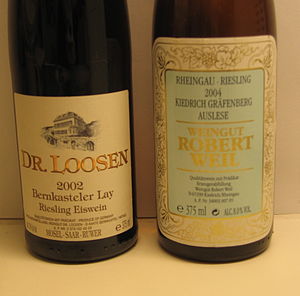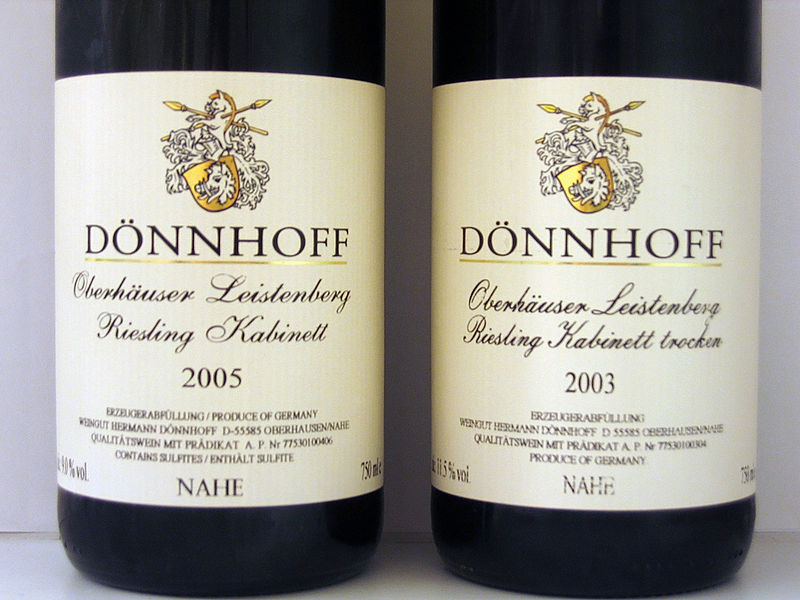German wine classification consists of several quality categories and is often the source of some confusion, especially among non-German speaking wine consumers. The official classification is set down in the wine law of 1971, although some changes and amendments have been made since then. The classification is based on several factors, including region of origin, whether sugar has been added, and the ripeness of the grapes. The system is quite different from the FrenchAppellation d'Origine Contrôlée system, or the systems in most other countries. In addition, German wine labels can be confusing for non-German speakers, although they give much information to those who are able to read them.
In recent years, the official classification has been criticised by many of the top producers, and additional classifications have been set down by wine growers' organisations such as VDP, without enjoying legal protection. The two main reasons for criticism are that the official classification does not differentiate between better and lesser vineyards and that the quality levels are less appropriate to high-quality dry wines.

Bottles from two of Germany's top producers showing the various pieces of information that can be found on a German wine label.
The bottle on the left displays information in the following order: Producer (Dr. Loosen) - vintage - village (Bernkastel) and vineyard (Lay) - variety (Riesling) and Prädikat (Eiswein) - mandatory information in small print - alcoholic strength, region (Mosel-Saar-Ruwer) and volume.
The bottle on the right uses a slightly different order: Region (Rheingau) and variety (Riesling) - vintage - village (Kiedrich) and vineyard (Gräfenberg) - Prädikat (Auslese) - producer (Weingut Robert Weil) - volume and alcoholic strength.
The bottle on the left displays information in the following order: Producer (Dr. Loosen) - vintage - village (Bernkastel) and vineyard (Lay) - variety (Riesling) and Prädikat (Eiswein) - mandatory information in small print - alcoholic strength, region (Mosel-Saar-Ruwer) and volume.
The bottle on the right uses a slightly different order: Region (Rheingau) and variety (Riesling) - vintage - village (Kiedrich) and vineyard (Gräfenberg) - Prädikat (Auslese) - producer (Weingut Robert Weil) - volume and alcoholic strength.
Two of the basic parameters in the classification of German wines are sweetness and quality. Wine quality is to some extent a subjective judgement, and within the framework of any formal wine classification, different producers achieve very different results. However, the different quality categories used in classification of German wines are to some extent related to varying wine-making practices that generally are associated with different levels of quality:
- The EU category "quality wines" is by definition supposed to be superior to the category "table wines".
- A category that allows chaptalization is generally inferior to a category that does not allow chaptalization, if wines that are "true to terroir" are to be produced.
- A category that may only be produced in certain vineyard sites is generally superior to a category which may be produced anywhere.
- A category that requires the grapes or the wine to fulfill quality criteria (e.g. ripeness of the grapes) that are so stringent that they can not be met by most vineyard sites in most vintages, can also be considered superior to categories which can be produced from almost any vineyard in almost any vintage.
Applying these distinctions to the categories in German wine classification gives the following overview. The table is primarily drawn up with wines produced from riesling grapes in mind.
Sweetness Indicative sugar level Typical quality level grams per liter Low Medium Medium to high High Chaptalization allowed Chaptalization not allowed Table wine (EU) Quality wine (EU) From any vineyard
in any vintageOnly from classified vineyards
or
Usually not possible to produce
in any vineyard in any vintageIntensely sweet >150,
sometimes >200Trockenbeerenauslese
(Eiswein)Sweet 100-150 Eiswein
Beerenauslese
Auslese
(Especially if Goldkapsel or ***
has been added)Semi-sweet 30-60 Tafelwein QbA
LiebfraumilchSpätlese
KabinettAuslese
(Especially from Mosel)
Erste Lage Spätlese
Erste Lage KabinettOff-dry
Can taste "internationally dry"
if the acid level is sufficient10-20 Tafelwein
LandweinQbA feinherb
QbA halbtrocken
ClassicSpätlese feinherb
Kabinett feinherb
Spätlese halbtrocken
Kabinett halbtrockenAuslese feinherb
Auslese halbtrocken
ChartaDry 0-9 Landwein QbA trocken
ClassicSpätlese trocken
Kabinett trockenGrosses Gewächs
Erstes Gewächs
Erste Lage QbA
Selection
Auslese trocken
Quality categories
The 1971 German wine law defines four overall quality categories:
- Deutscher Tafelwein, or 'German table wine'
- This is the equivalent to vin de table. It must be produced exclusively from allowed German-grown grape varieties in one of the five Tafelwine regions. Region or subregion must be indicated on the label. The grapes must reach a must weight of 44°Oe on the Oechsle scale (5% potential alcohol) in most regions, with the exception of Baden where 50°Oe (6% potential alcohol) must be reached. The alcohol content of the wine must be at least 8.5% by volume, and concentration or chaptalization can be used to reach this level. They must reach a total acidity of at least 4.5 grams/liter. Tafelwein (without "Deutscher") can be a so-called Euroblend, a table wine made from grapes grown in several European countries.
- Deutscher Landwein, or 'German country wine'
- This is the equivalent to vin de pays, and was introduced with the 1982 harvest. Regulations are similar to those for Deutscher Tafelwein, but must come from one of the 19 Landwein regions, the grapes must reach 0.5% higher potential alcohol, and the wine must be dry (trocken) or off-dry (halbtrocken) in style, i.e. may not be semi-sweet. "Landwein" can also refer to German fruit wines.
- Qualitätswein bestimmter Anbaugebiete (QbA), or quality wine from a specific region.
- These wines must be produced exclusively from allowed varieties in one of the 13 wine-growing regions (Anbaugebiete), and the region must be shown on the label. The grapes must reach a must weight of 51°Oe to 72°Oe depending on region and grape variety. The alcohol content of the wine must be at least 7% by volume, and chaptalization is allowed. QbA range from dry to semi-sweet, and the style is often indicated on the label. There are some special wine types which are considered as special forms of QbA. Some top-level dry wines are officially QbA although they would qualify as Prädikatswein. It should be noted that only Qualitätswein plus the name of the region, rather than the full term Qualitätswein bestimmter Anbaugebiete is found on the label.
- Prädikatswein, recently (August 1, 2007) renamed from Qualitätswein mit Prädikat (QmP) (superior quality wine)
- The top level of the classification system. These prominently display a Prädikat from Kabinett to Trockenbeerenauslese on the label and may not be chaptalized. Prädikatswein range from dry to intensely sweet, but unless it is specifically indicated that the wine is dry or off-dry, these wines always contain a noticeable amount of residual sugar. Prädikatswein must be produced from allowed varieties in one of the 39 subregions (Bereich) of one of the 13 wine-growing regions, although it is the region rather than the subregion which is mandatory information on the label. (Some of the smaller regions, such as Rheingau, consist of only one subregion.) The required must weight is defined by the Prädikat, and the alcohol content of the wine must be at least 7% by volume for Kabinett to Auslese, and 5.5% by volume for Beerenauslese, Eiswein and Trockenbeerenauslese.
Under the European Union wine quality grouping, Tafelwein and Landwein belong to the group of table wines, while QbA and Prädikatswein belong to the group of quality wines or VQPRD (Vin de qualité produit dans une région déterminée). In 2005, Tafelwein and Landwein only accounted for 3,6% of total production, QbA 49,6% and Prädikatwein (then called QmP) 46,8%. In most European countries, table wines make up a much higher proportion of the total production. While there are many German wines of excellent quality, the difference in comparison to other countries lies more in the national wine law and how it is applied by the growers. A case in point is Liebfraumilch, which foreign wine drinkers often see as the "simplest" German wine, but which is considered to be a special form of QbA and therefore a quality wine!
Prädikat designations
The Prädikatswein (formerly QmP) category of the classification contains most high-quality German wines, with the exception of some top-quality dry wines. The different Prädikat designations differ in terms of the required must weight, the sugar content of the grape juice, and the level required is dependent on grape variety and wine-growing region and is defined in terms of the Oechsle scale. In fact the must weight is seen as a rough indicator of quality (and price). The Prädikat system has its origin at Schloss Johannisberg in Rheingau, where the first Spätlese was produced in 1775 where wines received different colour seals based on their must weight.
The different Prädikat (superior quality wine) designations used are as followed, in order of increasing sugar levels in the must:
- Kabinett
- fully ripened light wines from the main harvest, typically semi-sweet with crisp acidity, but can be dry if designated so.
- Spätlese - meaning "late harvest"
- typically semi-sweet, often (but not always) sweeter and fruitier than Kabinett. Spätlese can be a relatively full-bodied dry wine if designated so. While Spätlese means late harvest the wine is not as sweet as a dessert wine.
- Auslese - meaning "select harvest"
- made from selected very ripe bunches or grapes, typically semi-sweet or sweet, sometimes with some noble rot character. Sometimes Auslese is also made into a powerful dry wine, but the designation Auslese trocken has been discouraged after the introduction of Grosses Gewächs. Auslese is the Prädikat which covers the widest range of wine styles, and can be a dessert wine.
- Beerenauslese - meaning "select berry harvest"
- made from individually selected overripe grapes often affected by noble rot, making rich sweet dessert wine.
- Eiswein (ice wine)
- made from grapes that have been naturally frozen on the vine, making a very concentrated wine. Must reach at least the same level of sugar content in the must as a Beerenauslese. The most classic Eiswein style is to use only grapes that are not affected by noble rot. Until the 1980s, the Eiswein designation was used in conjunction with another Prädikat (which indicated the ripeness level of the grapes before they had frozen), but is now considered a Prädikat of its own.
- Trockenbeerenauslese - meaning "select dry berry harvest" or "dry berry selection"
- made from selected overripe shrivelled grapes often affected by noble rot making extremely rich sweet wines.
The minimum must weight requirements for the different Prädikat designations are as follows. Many producers, especially top-level producers, exceed the minimum requirements by a wide margin.


No comments:
Post a Comment